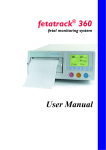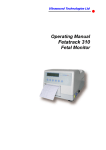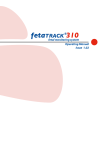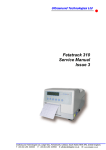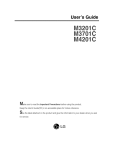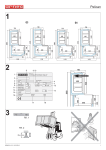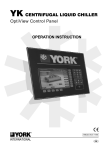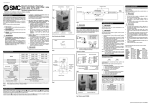Download - Frank`s Hospital Workshop
Transcript
Operating Manual PFM1 Fetal Monitor Ultrasound Technologies Ltd Foresters House, Itton, Chepstow, Gwent. NP6 6BZ U.K. Telephone +44 (0) 1291 641301 Fax +44 (0) 1291 641302 Contents About This Manual.......................................................................................................... 1 Safety In Use ................................................................................................................... 2 Special Precautions........................................................................................................................................... 2 Electrical Shock Hazard .................................................................................................................................. 2 Explosion Hazard .............................................................................................................................................. 2 Handling the Delicate Transducers................................................................................................................ 3 Symbols Used.................................................................................................................................................... 3 Parts and Their Functions .............................................................................................. 4 PFM1 Front Panel Controls ............................................................................................................................ 4 Recorder On/Off ....................................................................................................................................... 4 Front Panel Event Mark........................................................................................................................... 4 Volume Up ................................................................................................................................................. 4 Volume Down ........................................................................................................................................... 4 US1 / US2 Transducer Select ................................................................................................................. 4 Toco Zero ................................................................................................................................................... 4 Indicators and Connectors............................................................................................................................... 5 ’Power On’ Indication.............................................................................................................................. 5 RS232 Output............................................................................................................................................ 5 Remote (Patient) Event Marker.............................................................................................................. 5 Probe Connection...................................................................................................................................... 5 Operating Procedures..................................................................................................... 6 User Configuration ........................................................................................................................................... 6 The Printer.......................................................................................................................................................... 8 Ultrasound Fetal Monitoring........................................................................................................................... 9 Uterine Activity Monitoring ......................................................................................................................... 10 Fetal Activity ................................................................................................................................................... 10 Interpretation ................................................................................................................................................... 11 Troubleshooting ............................................................................................................12 No Display Information on LCD ................................................................................................................. 12 Keyboard Does Not Respond....................................................................................................................... 12 No Sound From Loudspeakers ..................................................................................................................... 12 No FHR Information on Display or Recorder ........................................................................................... 12 No Chart Printed ............................................................................................................................................. 12 Maintenance ..................................................................................................................13 General.............................................................................................................................................................. 13 System Cabinet........................................................................................................................................ 13 Transducers .............................................................................................................................................. 13 Specification..................................................................................................................14 PFM1OpManualIssue5 About This Manual This booklet explains the operation and use of the PFM1 Antenatal Cardiotocograph. Care has been taken during the design and manufacture of this product so that it satisfies all of the current safety standards set down by BS EN60601 To achieve the best from this product read the following sections several times and if you have any problems in the operation of a particular part of the product then contact your dealer immediately or contact : Ultrasound Technologies Ltd. German Office Lodge Way, Portskewett GB-Caldicot NP26 5PS Phone: +44 (0) 12 91 / 425 425 Fax: +44 (0) 12 91 / 427 093 Email: [email protected] Website: http://www.doppler.co.uk Kleinenbroicher Str. 54a D-41352 Korschenbroich +49 (0) 2161 / 677 194 +49 (0) 2161 / 677 195 [email protected] http://www.mydoppler.de A service manual containing circuit descriptions, diagrams, parts and spares lists is available for the PFM1 by contacting the address above. To maintain the PFM1’s performance it is recommended that it be included in a periodic maintenance program. The user preventative maintenance program is covered in this manual. Maintenance outside the scope of the user should be undertaken on an annual basis by trained service personnel; full details are available from your supplier, service centre or from Ultrasound Technologies Ltd. The PFM1 is supplied complete with the following: PFM1 Single Fetus Monitor US1 Monitoring Tr ansducer External Toco Transducer Patient Event Marker Belt set (x1) Paper spindle Chart roll (x1) Power Cord Operating instructions Doppler size Coupling gel PFM1OpManualIssue5 PFM1 Twin Fetus Monitor US1 Monitoring Transducer US2 Monitoring Transducer External Toco Transducer Patient Event Marker Belt set (x2) Paper spindle Chart roll (x1) Power Cord Operating instructions Doppler size Coupling gel Page 1 Safety In Use Special Precautions Your PFM1 Antenatal Cardiotocograph has been designed for electrical safety. All the safety and operating instructions should be read before operating the PFM1. Failure to do so could result in injury to the user, patient, or damage to the system and accessories. Electrical Shock Hazard l Do not defeat the grounding integrity of this system. Protection against electrical shock, in the event of failure of basic insulation, is provided by the connection of the chassis to the safety ground. Safety grounding occurs only when the 3-wire cable and plug provided with the system are connected to a properly grounded receptacle. l Do not remove the system cover. The system should be serviced by trained and qualified personnel only. Contacting the hazardous voltages within the system could cause serious injury. l Do not use the system if the power cord has any cuts or openings. l Do not use the transducer if the cable has any cuts or openings. l Do not use the transducer if the transducer face is cracked or chipped. l Do not immerse the transducer cable connectors in any liquids. l Should the electrical safety fuses have to be replaced, use only fuses of the same type and rating. Don not use this device at or close to water deliveries! Explosion Hazard Do not operate or use this system in the presence of flammable anesthetics or gases as it could lead to explosion. PFM1OpManualIssue5 Page 2 Safety In Use Handling the Delicate Transducers The transducers are delicate parts of the ultrasound system and should be treated with care. The delicate crystals in the transducer may crack and render the transducer unusable if the transducer is subject to shock. Room temperature liquids should be used for cleaning. Never use alcohol or mineral oil as an acoustic coupling agent as transducer or cable damage could occur. Symbols Used The following symbols are used on the PFM1 and are in accordance with BS EN60601-1-1990. Where they are associated with the connection of external equipment, that equipment must meet the relevant safety standards in all cases. Alternating current Associated with power on indicator Type B Equipment Unit classification Off (power: disconnection from the mains) On (power: connection to the mains) Attention, consult accompanying documents. Associated with auxiliary connections see operating instructions. Dangerous voltage. Associated with components internal to the PFM1. PFM1OpManualIssue5 Page 3 Parts and Their Functions PFM1 Front Panel Controls The front panel control area contains 6 buttons used to control the operation of the unit, they are all indicated by icons to aid language variations. Volume Up Event Mark 1. Places arrow in upper portion of chart Volume Down Mains “ON” indicator Toco Zero. Sets Toco channel to preset baseline value. Recorder On / Off and speed control Select ultrasound channel for audio output and twins split trace. Recorder On/Off and Speed Change This button is used to control the operation of the recorder. Press once and the chart recorder will start, each consecutive short press will change the speed . Pressing and holding the button down will stop the recording. Event Mark 1 Places an event mark arrow at the top of the FHR scale . Volume Up This button is used to increase the audio volume level, or in configuration mode to change user options. Volume Down This button is used to decrease the audio volume level, or in configuration mode to change user operations. US1 / US1 Transducer Select and Twins trace mode. Pressing this button changes the selected probe from US1 to US2 for volume output. This is used when the unit is in twins mode with two US channels for listening to either of the two fetuses. If this button is held the trace format will change into two separate traces for twins monitoring, this mode is reset when the units power is removed. Toco Zero This button zeros the Toco trace to the selected baseline. PFM1OpManualIssue5 Page 4 Parts and Their Functions Inputs / Outputs and Displays ’Power On’ Indication The green LED associated with the above symbol indicates that power is connected to the apparatus when illuminated. RS232 Output This output is for the connection of an external computer for data transfer. The maximum voltage that can be applied to this output is 15VDC. WARNING: Any external equipment connected to this output must meet the relevant safety standard. Remote Event Marker Connection of an external event mark switch allows the patient to indicate events by printing an arrow in the gap between the FHR and UA traces. The maximum voltage that can be applied to this output is 15VDC. Probe Connections US1, US2, Toco This is for the connection of approved Doppler and Toco transducers. The maximum voltage that can be applied to this output is 15VDC. PFM1OpManualIssue5 Page 5 Operating Procedures Operating the PFM1 In this section, information is supplied which will help you use the PFM1 for the fist time. User Configuration Firstly connect the AC supply cord. It is necessary to set the operation of the PFM1 to meet your requirements. Before turning the PFM1 on, press and hold down the Toco Zero button. Then, whilst keeping the Toco Zero button pressed down, turn the PFM1 on by flicking the AC input on/off switch which is located on the rear of the unit as part of the AC line input socket. When the unit is on the front panel LED will be illuminated. The PFM1 starts and then enters its User Configuration Mode, release the Toco Zero button as soon as ‘Calibrate System’ is displayed . You are then prompted to enter the date if different to that displayed. To change the day and month press the Volume Up button. One press advances the day by one, pressing the Volume Up button for longer advances the day by 10. To change the year press the Volume Down button. One press advances the year by one, pressing the Volume Down button for longer advances the year by 10. When the correct date is displayed press the Toco Zero button once. You are then prompted to enter the time if different to that displayed. This works in a similar manner to the date with the Volume Up button advancing the hours and the Volume Down button advancing the minutes. When the correct time is displayed press the Toco Zero button once. You are then prompted to enter the Toco Base Line offset. This sets an artificial zero line for the toco transducer above zero, it can be set by pressing the Volume Up or Volume Down buttons for a value between 0 - 20. After setting this value the Toco will be set to this every time the Toco Zero switch is pressed, and allows small negative Toco excursions to be seen on the chart. When the correct time is displayed press the Toco Zero button once. PFM1OpManualIssue5 Page 6 Operating Procedures You are then prompted to enter the Toco Filter Value. This sets the filtering within the monitor to produce a smoother Toco trace if required. ( The filter can remove some of the maternal breathing artifact). It is set by pressing the Volume Up button for a value soothing value between 1sec and 2sec.. When the correct filter value is displayed press the Toco Zero button once. You are then prompted to enter the Toco Range. This sets the response of the Toco transducer to either a full scale of 100 or 200 on the chart print out. It is set by pressing the Volume Up button for a value between 100 and 200.. When the correct range is displayed press the Toco Zero button once. You are then prompted to enter the Chart recorder speed. This sets the initial turn-on speed of the chart recorder. Then once the chart is running the speed can be further changed to 1 ,2 or 3 cm/min. It is set by pressing the Volume Up button for a value of 1, 2 or 3 cm/min.. When the correct speed is displayed press the Toco Zero button once. You are then prompted to select the Data Block on or off. The Data Block is printed at the start of each recording, this function can be disabled by setting Data Block to off. It changes from on to off and back again by pressing the Volume Up button.. When the Data Block is set to your requirements press the Toco Zero button once. You are then prompted to select the Tachycardia Alarm on or off. The Tachycardia Alarm is triggered when the system detects a Tachycardia above 170 bpm and an alarm tone sounds. The alarm is tone is stopped by pressing the units volume button. Tachycardia Alarm can be set to on to off and back again by pressing the Volume Up button.. When the Tachycardia Alarm is set to your requirements press the Toco Zero button once. You are then prompted to select the Bardycardia Alarm on or off. The Bradycardia Alarm is triggered when the system detects a Bradycardia below 100 bpm and an alarm tone sounds. The alarm is tone is stopped by pressing the units volume button. Bradycardia Alarm can be set to on to off and back again by pressing the Volume Up button.. When the Bradycardia Alarm is set to your requirements press the Toco Zero button once. The PFM1 will then restart and operate according to your settings. The PFM1 is now operational, and the LCD screen will show US1 --- us2 --(if the unit is only a single fetus monitor it will only display US1 ---) and a Toco value. PFM1OpManualIssue5 Page 7 Operating Procedures The Printer The PFM1 prints on plain thermal paper using a thermal array print head. Fetal heart rate, uterine activity, and fetal movement are recorded together with date, time, recorder speed and mode. The printer also prints a header block each time the printer is turned on and the units chart scale. To load the printer with paper, open the printer door by pressing firmly on the lid of the printer. It will then release and can be lifted to a fully open position. Remove the chart roll bar from inside the printer and place through the centre of the new chart roll. (The chart roll must be removed from its protective plastic cover and the sticky tab holding the roll together removed.) Insert the roll into the recorder so that the thermal side of the paper is uppermost. Thermal side uppermost Chart roll Printer roller Pull the paper out of the front of the unit making sure it is positioned below the door catches. Close the door and latch by pressing down firmly on it. To operate the printer press the Recorder On/Off button (situated immediately to the right of the printer door). The printer will start to run and the chart speed will be shown in the LCD display. To turn the printer off press and hold the Recorder On/Off button until the printer stops. (This only operates after the data block has been printed). A small amount of paper will be fed out at high speed. The printer will record at 1, 2 or 3 cm/min. To change the speed during recording simply press the Recorder On/Off button momentarily. The PFM1 can be run at the speed of your choice, and will always start at this pre-programmed speed every time the printer is turned on. For details of how to change the pre-programmed speed refer to ‘User Configuration’. PFM1OpManualIssue5 Page 8 Operating Procedures Ultrasound Fetal Monitoring The PFM1 ultrasound transducer is used to detect and monitor the fetal heart beat. The PFM1 can monitor twins and if this option is chosen it is supplied with two Ultrasound transducers. The primary Ultrasound Transducer (always supplied ) has a yellow coded plug while the twin channel has a blue coded plug. Push the relevant plug firmly into is colour coded front panel US socket and turn the unit on. Locate a clear fetal heart sound using a Doppler Fetal Heart Detector and secure the stretch belt in position, so that it passes over the transducer site, and clamp in place by fastening the Velcro tabs back onto the surface of the belting after feeding through the transducer. Apply gel to the surface of the trans ducer locating it approximately in the position determined by the Doppler detector. Position the transducer to obtain the clearest fetal heart sound. The heart rate processor will start to calculate heart rate within a few seconds and the heart rate can be observed on the LCD display. Correct operation can be verified by observing that the pulse lamp is flashing at the heart rate. The heart shaped fetal pulse indicator is also used as a signal quality indicator. When positioning the transducer observe the indicator, which should be solid under the best signal conditions. If this indicator is only showing an outline heart then this is an indication that the signal quality is not optimum. Improved recordings can be obtained by repositioning the transducer so that this indicator always shows a solid heart. In the absence of signals of adequate quality this indicator will be permanently off. The audio volume can be increased by pressing the volume up button marked with the up arrow. Conversely to decrease audio volume press the button marked with the down arrow. In twins mode the audio output is selected for either channel by pressing the US 1/2 button. The selected channel is indicated on the LCD display by the capital US letters. Once a clear fetal heart signal has been located set the volume to the desired level using these controls. Transducer position should be checked at least half-hourly during labour-monitoring or prolonged NST. When repositioning the transducer, further coupling gel may be required When repositioning the transducers always ensure that the fetal pulse indicates the optimum signal conditions. Results will vary from one patient to another, but in all cases good transducer positioning is essential, and this may be aided by the use of a liberal amount of coupling gel. With the fetus in the vertex presentation, and the mother sitting or supine, the clearest sound will normally be found on the midline below the umbilicus. In the lateral position, clearer sounds may be found with the transducer displaced from the centre line to the upper surface of the abdomen. The clearest signals in breach presentation may be located higher and to one side. PFM1OpManualIssue5 Page 9 Operating Procedures Transducer position which results in sounds with a strong placental or cord signal should be avoided, as these frequently render traces with artifacts. It is important that a distinct fetal heart sound is present during monitoring for correct function of the unit . Any doubt about fetal variability should be checked by listening to the audible signal, or by an alternative diagnostic technique. A simple check of the ultrasonic system can be made by holding the transducer against the palm of the hand and stroking the back of the hand at a fixed rate, for example, twice per second. A clear audible signal should be heard and the digital display should show a rate after approximately five seconds. With the printer running this rate will be recorded on the chart. Uterine Activity Monitoring The Toco transducer is used to monitor uterine activity. The transducer plug is colour coded grey for ease of identification. To monitor uterine activity plug the Toco transducer into the grey UA input socket. The Toco transducer is sealed to prevent the ingress of fluids. NO coupling gel is required for this transducer to operate correctly. Place the transducer on the centre line over the fundus in a position where the uterus is firm, and secure in place with the stretch belting. Attach belt in the same fashion as with the ultrasound transducer. Once the transducer is in position, push the Toco Zero button on the front panel to zero the recording. The position of the zero baseline can be set to suit individual preferences. For details of how to change the pre-programmed baseline refer to ‘User Configuration’. Fetal Activity Fetal activity may be recorded with the assistance of the patient. A hand-held marker switch is provided for this purpose and this is plugged into the socket immediately to the right of the UA input on the front of the unit. If the patient feels movement of the fetus she may press the switch and this will mark the paper with an arrow in the gap between the HR and UA traces. Alternatively this marker may be used by the midwife to indicate any changes made during the procedure, such as repositioning of the transducers or movement of the patient. A front panel event marker is also provided, and this marks the trace on the top edge of the HR scale. This can be used where two types of indication are required. PFM1OpManualIssue5 Page 10 Operating Procedures Interpretation The following is intended only as a brief guide. For a fuller explanation of the interpretation of chart records, refer to suitable reference books. During the antepartum period the Non Stress Test (NST) is an accurate means of predicting fetal well-being. The criteria proposed by Schifrin et al for the interpretation of the NST is summarised. Reactive - accelerations of 15 BPM or more which last for 15 seconds or longer twice in any 10 minute period. These may be accompanied by fetal activity. Non-reactive - evidence of fetal movement during a forty minute period, but without the reactivity indicated above. Unsatisfactory - recording quality too poor to determine the above criteria. Stimulation of the fetus, or repositioning of the transducers may result in an improved recording. Results from the NST may indicate the requirements to perform other diagnostic checks such as the Contractions Stress Test (CST). PFM1OpManualIssue5 Page 11 Troubleshooting The information in this section will help you to check and correct common operation and system problems. Refer to the troubleshooting hints which deal with your problem. Perform the suggested steps. If the problem is not solved, check once again to make sure that you have used all of the suggested steps to resolve the problem. Electronic failures and service procedures are not included in this manual, as all servicing of the system must be performed by a qualified service technician. Valuable time however can be saved by documenting the problem . In general, when you have a problem, check your control settings to be sure that they are in proper operating position. Consult the appropriate section in this manual for specific information on particular controls or operating modes. WARNING: Disconnect system from the power source before checking fuses and connections. Check all connections and fuses. For replacement fuses consult the technical specifications for specific ratings required. No display information on LCD Verify the system is on and that the fuses are intact.: · Keyboard does not respond · · Reset system by turning off then back on. Verify the system is on and that the fuses are intact. No sound from loudspeaker. · · · · Verify the system is on and that the fuses are intact. Check volume control is set high. Check that the correct transducer has been selected. Check connection of the transducer. No FHR information on display or FH trace printed on recorder. · · · Check that the correct transducer has been selected and connected to the patient. Check connection of the transducer. Check for audio FH complex and reposition transducer until clearly heard. No chart printed . · · · · · PFM1OpManualIssue5 Verify the system is on and that the fuses are intact. Check that the recorder is turned on. Check paper is inserted into the recorder correctly. Check recorder door is correctly closed Check that paper moves out of the recorder at the correct rate. Page 12 Maintenance The following are the user preventative maintenance tasks. It is recommended that these be performed on a regular basis at a frequency determined by the usage of the equipment, but not less than once every month. WARNING: Before undertaking any of these tasks disconnect the unit from the mains. General Check all cables, connectors and transducers for damage and repair or replace where necessary. The repair may involve your local service centre, supplier or Ultrasound Technologies Ltd. For advise on any damaged part contact them immediately. Cleaning - Enclosure Clean the exterior of the system with a soft dry cloth. In the event of stubborn spots, disconnect the system from the power source. Use a soft cloth that has been dampened - not soaked - in a mild detergent solution or isopropyl alcohol. Be sure to keep excess moisture from entering the cabinet via any openings that may be present. Cleaning - Transducers Use a cloth dampened in a mild detergent solution or isopropyl alcohol to clean the transducer and cable. Remove all traces of the detergent or alcohol by wiping with a cloth dampened in clear water. Never soak the transducer cable or connector. WARNING: Transducers must never be exposed to gas or heat sterilisation. PFM1OpManualIssue5 Page 13 Specification Specification Ultrasound Frequency Transducer Audio Response Range Power Output Indicators 1.8 and 2.1 MHz continuous wave Multi element wide angle 300 - 1 Khz 50 - 210 bpm Within European standard LCD heart rate and pulse indication Transducer Response Scale Indicators Differential external pressure transducer 0 - 5 Hz 0 - 100 LCD Toco level indication Toco Data Presentation Strip chart recorder and alphanumeric display module. Printhead Resolution Speeds Paper Paper type 4 inch thermal solid state printhead 8 dots / mm 1,2,3,cm/min Roll or Z fold Plain black thermal Display Controls 32 character by 2 line LCD display module 6 control buttons (for Paper Start /Stop, Volume Up, Volume Down, US½, Toco Zero and Event Mark) Green power on/ off Indicators Power Supply AC input voltage Frequency Power 200 - 260 VAC or 100 - 130 VAC (User selected) 46 - 64 Hz 60VA Enclosure Material Steel. Unit Electrical Designation Designed to BS EN60601-1-1990 Class 1 Type B Safety PFM1OpManualIssue5 Page 14 Specification Computer interface Transfer Data Rate Data Standard Data Format 3 wire RS232 9600 baud 8 bits no parity 1 stop bit UltraTec Comms Standard The following Consumables are available for use with the PFM1 Belt set (5 per pack) Paper spindle Chart roll (10 rolls per pack)) Power Cord Doppler size Coupling gel This Equipment complies with the essential requirements of the European Council Directive. 93/42/EEC 0120 Guidelines for Identifying and resolving adverse EMC conditions Emissions Care has been taken through the design and manufacturing processes to minimise the EM emissions that may be produced by this equipment. However, in the unlikely event that the unit causes an EM disturbance to adjacent equipment, we suggest that the procedure is carried out 'out of range' of the affected equipment. Immunity If the user has any doubt regarding the unit's EM immunity during routine operation, we suggest that the source of EM disturbance is identified and its emissions reduced. If the user has any doubt regarding the identification and resolution of adverse EM conditions, they may contact Ultrasound Technologies Ltd to seek advice PFM1OpManualIssue5 Page 15



















